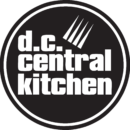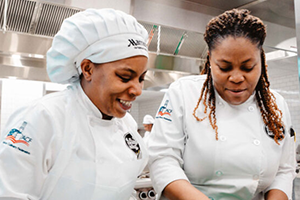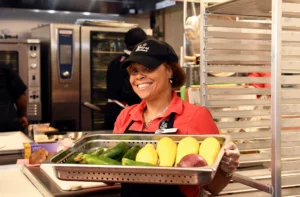The Seeds
The fight for fairer access to healthy food in DC may have generated significant headlines in recent months, but the fight itself has been a generational one. More than half of the large supermarkets with the greatest output in D.C. closed in the 1960s and 1970s, and the decades since have seen a persistent and widening “grocery gap” in DC’s historically underserved and predominately Black communities. The fight has included legislative efforts, public investments, charitable programs, community organizing campaigns, and even a high-profile Grocery Walk.
And in 2011, Healthy Corners became part of this fight. Twelve years after DC Central Kitchen’s ‘whiteboard’ idea to bring healthier food to corner stores got a kickstart from the FEED DC Act and a seed investment from the District of Columbia Government, the program is now a national model for building on a community’s existing assets to make healthy food more accessible and sustainable in areas without supermarkets. What began as an effort with one vehicle to bring a small assortment of fruits and vegetables to 30 small corner stores is now an award-winning distribution and technical assistance effort that equips 15,000 SNAP customers to use their benefits to select healthy items right in their own communities each year, with a total of 54 participating Healthy Corners locations District-wide.
“We have a great advantage in having a program that started in 2011 due to the partnerships and systems we have built and strengthened over time,” said Yael Reichler, Director of Healthy Corners. The program is much more than a last-mile distribution solution for healthy foods – though it is also that. “Through one-on-one and group training sessions for small business owners, providing equipment and marketing, and serving as a food hub year-round, Healthy Corners is positioned to support corner stores in expanding their capacity for selling healthy products by reducing as many challenges for them as possible. Healthy Corners’ support of corner stores allows the store network to offer high-quality fresh (and frozen) produce at affordable prices to community members who have very limited access to produce otherwise.”
Healthy Corners might be known by many for the dozens of varieties of fruits and vegetables it delivers every day, but the program’s most essential ingredient is trust. Through the efforts of our program staff, culinary graduates, and community-based Store Navigators – area residents employed by DC Central Kitchen as customer and store liaisons – we have been keenly focused on building shared trust for more than a decade.
According to Healthy Corners Program Specialist and DC Central Kitchen culinary graduate Manouchka Bolden, the most significant change she’s seen over the years is the growing buy-in and engagement from the store owners. “Relationships have a lot to do with everything we do,” she said. “Store owners are engaging with us more than they ever were before. At the beginning, for many of them, it was just about selling fruits and vegetables. But now they’re seeing the vision beyond it – these businesses are expanding, they’re creating more space, they’re coming out to learn (at our Community of Practice) and they’re asking for events at their stores.”
The Growth
Healthy Corners sales are up 16% since October 2022 and now, city-wide, 54 small corner stores are part of our Healthy Corners network. Over the past year, we even generated a 70% increase in local produce and products sold thanks to close coordination with farmers and food hubs in our region. This growth comes at a crucial time. With the number of supermarkets located East of the Anacostia River still painfully low – and some local concerns about the number falling even lower – Healthy Corners stores are an increasingly vital access point. At the same time, with 60,000 people in Wards 7 and 8 receiving SNAP benefits, access isn’t the only barrier. With now rolled back-pandemic emergency SNAP allotments , some SNAP recipients may have a maximum of only $30 per month in EBT dollars.
In 2018, Healthy Corners became the first program in the country to introduce Federally supported ‘produce incentives’ at a significant number of urban corner stores. Today, these additional benefits for low-income customers using SNAP benefits to select fruits and vegetables are an essential part of many DC corner stores’ business model. Through Healthy Corners’ ‘SNAP Match’ initiative, low-income shoppers can receive a $5 coupon for fresh or frozen produce when they include one piece of produce in their initial SNAP-eligible transaction of $5 or more. This past year, we have helped three additional stores begin offering these SNAP Match produce incentives: Food 7 Store in Ward 6, Top Mart in Ward 8, and Neighborhood Market in Ward 5.
“With 33 of our 54 Healthy Corners stores now accepting these powerful SNAP Match produce incentives, we are working to expand the value of SNAP for as many community members who need it as possible,” Reichler said. “The growing popularity of the SNAP Match program speaks for itself; D.C. residents are seeking ways to eat healthier with limited resources and access.”
The Fruits
Since 2018, Healthy Corners customers have redeemed an estimated $1 million worth of produce incentives, meaning 1 million more dollars were spent on fresh fruit vegetables than previously would have – or could have – been. That is a massive win/win for shoppers with limited incomes and local DC businesses.
According to Petros Michael, the owner of two stores in our SNAP Match program, the SNAP Match incentive primarily impacts “older people, people who don’t drive, [people] who have to get on a bus, [people who] don’t have much time. It’s way cheaper than the grocery store to get produce… especially for older people – they save money and time, and it’s more comfortable when they don’t have to ask other people to do it for them.”
The owner of Holiday Market in Ward 8, Semere Abraha, a Healthy Corners partner since 2015, notes how working with Healthy Corners has increased profits for his business. “We’re selling a lot more now, it’s good profit,” he says, “[Customers] come purposefully for [the program], because they know they can get that additional $5, and so I see a lot of foot traffic. It’s good in every corner.”
This past August, the Nutrition Incentive Hub released a new tool to calculate the economic impact of nutrition incentive programs taking place across the country. This economic impact calculator is tailored to each state’s economy and accounts for location-specific economic factors involved in nutrition incentive programs that uniquely support the local food system and the local economy.
According to this calculator, the $1 million in redeemed benefits at Healthy Corners stores directly translates into an economic impact of $1.7 million for Washington, D.C in that span.
Rooting for Growth
The future of Healthy Corners is one that integrates the many pieces that make up the big picture of a sustainable food system. Healthy Corners Program Manager Roselind Brown is excited to expand “an increased offering of locally grown products in neighborhood corner stores. Healthy Corners is more vital than ever as food prices continue to rise, and food access remains challenging for many D.C. residents.”
“We are prioritizing local sourcing with an attention to making an impact across the local and regional food system, from local farmers to small retailers to community members,” Program Director Reichler said. “Food insecurity is a symptom of many broader systemic challenges and injustices, so addressing the system as a whole is an essential part of our program and DC Central Kitchen’s approach to supporting hunger issues in Washington D.C.”
From start-up program to sustainable model, Healthy Corners has grown tremendously in the past 12 years and is poised to attain record sales and measurable results in the years ahead. Thanks to the added aggregation and processing capacity of our brand-new facility, Healthy Corners seeks to empower retailers to sell 500,000 units of affordable fruits and vegetables annually by 2025. You can learn more about our Healthy Corners program here or by downloading our app.






